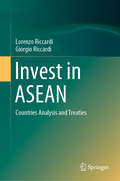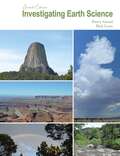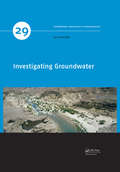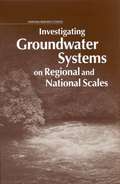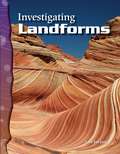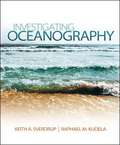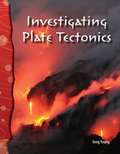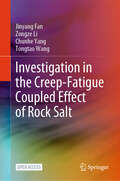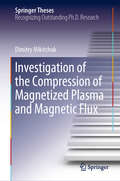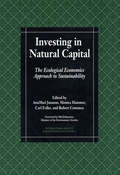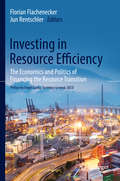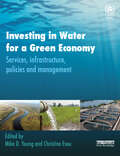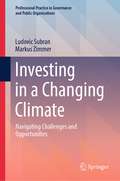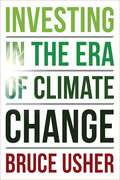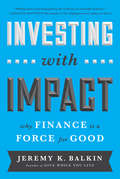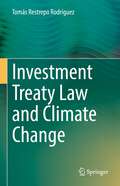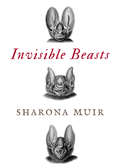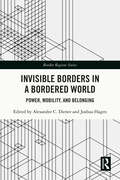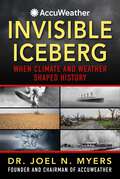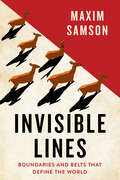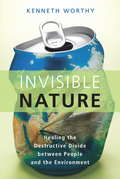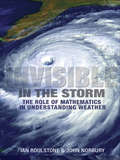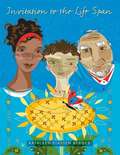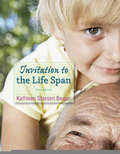- Table View
- List View
Invest in ASEAN: Countries Analysis and Treaties
by Lorenzo Riccardi Giorgio RiccardiThis book highlights the main features of the economic, commercial, political, fiscal and financial systems of each of the ASEAN countries from a domestic and an international point of view. Moreover, it analyses the most relevant international treaties signed by ASEAN’s members. Published after the 50th anniversary of ASEAN to promote the association, the book is a valuable tool for practitioners who are interested in developing economic activities or investments in this area.
Investigating Earth Science
by Dusty Girard Rick LynnInvestigating Earth Science is a lab manual designed to meet the requirements of an introductory geology course for non-science majors. <p><p> In order to meet the needs of a broad based geology course many topics are covered including the scientific method, mineral and rock formation and identification, water issues, coordinate systems and mapping, geologic time, the atmosphere, weather and climate, and astronomy. <p><p> This lab manual is designed to complement the lecture component of an introductory geology lecture course to reinforce and enhance student’s understanding of Earth processes, human interaction with our environment and the place of the Earth and humans in our solar system and universe. The major goal of this lab manual is to help students understand the importance of how science works, how scientists think and how science impacts the student’s life on a daily basis.
Investigating Earth Systems: Investigating Our Dynamic Planet
by Michael J. Smith John B. Southard Colin MablyAn Inquiry program that goes into detail about investigating our planet Earth.
Investigating Groundwater (IAH - International Contributions to Hydrogeology #29)
by Ian AcworthInvestigating Groundwater provides an integrated approach to the challenges associated with locating groundwater. Uniquely, the book provides a review of the wide range of techniques that can be deployed to investigate this important resource. Many of the practical examples given are based upon Australian experience but the methods have worldwide applicability. The book is published in colour and includes many original diagrams and photographs. Particular effort has been made to provide consistent terminology and SI units are used throughout the text. <P><P>Investigating Groundwater starts with an introduction to the historical significance of groundwater and gives an account of climate change. A description of the occurrence of groundwater in different rock types is then provided. A detailed account of surface water techniques is then followed by an account of the interconnections between surface water and groundwater. Four chapters describing groundwater hydraulics are then followed by four chapters describing the latest geophysical techniques. Once the best location of a borehole is determined using these techniques; chapters then describe appropriate drilling methods to use; provide a wide ranging review of geophysical logging, hydrochemical and isotopic techniques, before concluding with a detailed description of groundwater flow to a well. <P><P>Written for a worldwide audience of degree level geology/engineering practitioners, academics and students involved in groundwater resource investigation methods; Investigating Groundwater is essential reading for those involved in groundwater research. <P><P>Key Features: <li>Presents the theoretical background and a detailed description of the techniques used in the investigation of groundwater. <li>Describes the general occurrence of groundwater in different rock types; surface water hydrology and interconnected surface and groundwater systems. <li>Provides detailed descriptions of geophysical techniques (seismic, electrical, gravity and heat) and an account of available geophysical logging methods. <li>Reviews hydrochemical and isotope methods, followed by an account of drilling techniques. <li>Gives a detailed account of radial flow to a well, including appropriate modelling and pump-testing techniques and a consideration of non-linear flow. <P><P>Of interest to anyone involved in the development of groundwater resources, either for domestic supply, for agriculture or for mining.
Investigating Groundwater Systems on Regional and National Scales
by Committee On Usgs Water Resources ResearchA report on Investigating Groundwater Systems on Regional and National Scales
Investigating Landforms: Earth and Space Science (Science Readers)
by Lynn GorpLandforms are features on the earth's surface that are made naturally. Mountains, plains, and plateaus are all examples of landforms. The study of landforms is called geomorphology. Scientists can learn about the past and even predict future changes by studying landforms. Today we can take pictures of landforms from airplanes and satellites.
Investigating Oceanography, 1st Edition
by Keith A. Sverdrup Raphael KudelaInvestigating Oceanography is the product of decades of experience in oceanographic research and teaching in the classroom. The information in this book is enhanced by beautiful art and an exciting design that capture both the eye and the imagination. In each chapter, the discussion of new ocean science issues scaffolds on knowledge gained in previous chapters. Information in this book is both relevant to students' lives and up-to-date with the latest discoveries in oceanography. The book help students understand the intimate relationship between the oceans and their own well-being, and know the importance of having a combination of dedicated scientists who continue to explore the oceans and a knowledgeable public committed to protecting the ocean environment. Investigating Oceanography offers numerous aids to engage students and help them identify and understand key concepts in ocean science.
Investigating Plate Tectonics: Earth and Space Science Readers
by Greg YoungThrough colorful images, helpful charts and graphs, and easy-to-read text, readers will discover such fascinating topics as magnetic pole reversal, divergent and convergent plate boundaries, the ocean-continental division, and the San Andreas Fault. A captivating lab activity is featured to encourage children to further explore geology.
Investigation in the Creep-Fatigue Coupled Effect of Rock Salt
by Chunhe Yang Tongtao Wang Jinyang Fan Zongze LiThis open access book provides the uniaxial, triaxial, fatigue, creep, creep-fatigue loading tests in order to investigate the salt mechanical response and the related damage mechanisms defining relation between plastic deformation, dilatancy and damage. Based on the experimental results, a new creep-fatigue constitutive model for salt rock that considers creep-fatigue interaction was established by incorporating a state variable that characterizes rock hardening level on the basis of the Norton creep model. Different salt rock mechanical test data sets with varying stress paths were used to validate this creep-fatigue constitutive model. The fit curves and test curves of the stress paths demonstrate good consistency, indicating that the model comprehensively considers the effects of time, load, and state on salt rock's creep-fatigue, effectively describing the creep-fatigue plastic deformation features of salt rock under different stress paths.
Investigation of the Compression of Magnetized Plasma and Magnetic Flux (Springer Theses)
by Dimitry MikitchukThe present research studies the fundamental physics occurring during the magnetic flux and magnetized plasma compression by plasma implosion. This subject is relevant to numerous studies in laboratory and space plasmas. Recently, it has attracted particular interest due to the advances in producing high-energy-density plasmas in fusion-oriented experiments, based on the approach of magnetized plasma compression.The studied configuration consists of a cylindrical gas-puff shell with pre-embedded axial magnetic field that pre-fills the anode-cathode gap. Subsequently, axial pulsed current is driven through the plasma generating an azimuthal magnetic field that compresses the plasma and the axial magnetic field embedded in it.A key parameter for the understanding of the physics occurring during the magnetized plasma compression is the evolution and distribution of the axial and azimuthal magnetic fields. Here, for the first time ever, both fields are measured simultaneously employing non-invasive spectroscopic methods that are based on the polarization properties of the Zeeman effect. These measurements reveal unexpected results of the current distribution and the nature of the equilibrium between the axial and azimuthal fields. These observations show that a large part of the current does not flow in the imploding plasma, rather it flows through a low-density plasma residing at large radii. The development of a force-free current configuration is suggested to explain this phenomenon. Previously unpredicted observations in higher-power imploding-magnetized-plasma experiments, including recent unexplained structures observed in the Magnetized Liner Inertial Fusion experiment, may be connected to the present discovery.
Investing in Natural Capital: The Ecological Economics Approach To Sustainability (Intl Society for Ecological Economics)
by Carl Folke Robert Costanza Monica Hammer Annmari JanssonInvesting in Natural Capital presents the results of a workshop held following the second biannual conference of the International Society for Ecological Economics. It focuses on the relation of human development to natural capital, and the relation of natural capital to environmental processes.Because we are capable of understanding our impact on the environment and the importance of managing it sustainably, humans play a special role in our ecosystem. The book emphasizes the essential connections between natural ecosystems and human socioeconomic systems, and the importance of insuring that both remain resilient. Specific chapters deal with methodology, case material, and policy questions, and offer a thorough exploration of this provocative and important alternative to conventional economics.
Investing in Resource Efficiency: The Economics and Politics of Financing the Resource Transition
by Florian Flachenecker Jun RentschlerThis book covers the multi-faceted incentives, trade-offs, and challenges associated with the economics and politics of resource efficiency investments. By contributing a wide range of empirical evidence, practitioners' insights, and policy perspectives, this book carefully examines the role of resource efficiency in reconciling environmental and economic considerations. It also discusses the critical role of resource efficiency investments in mitigating climate change and enabling sustainable development. Featuring expert insights from academia, the European Commission, the European Investment Bank, and the European Bank for Reconstruction and Development, this book provides a policy oriented guide, reference, and toolbox for unlocking the potential of resource efficiency. To this end, it identifies practical measures for overcoming barriers and creating smart incentives for leveraging resource efficiency investments. Overall, this book brings together evidence to develop innovative ideas and strategies for improving the efficient use of resources and advancing clean and sustainable development."This book is an important and timely contribution", Angel Gurria, Secretary General, OECD
Investing in Water for a Green Economy: Services, Infrastructure, Policies and Management
by Christine Esau Michael D. YoungIn the context of the economies of the world becoming greener, this book provides a global and interdisciplinary overview of the condition of the world’s water resources and the infrastructure used to manage it. It focuses on current social and economic costs of water provision, needs and opportunities for investment and for improving its management. It describes the large array of water policy challenges facing the world, including the Millennium Development Goals for clean water and sanitation, and shows how these might be met. There is a mixture of global overviews, reviews of specific issues and an array of case studies. It is shown how accelerated investment in water-dependent ecosystems, in water infrastructure and in water management can be expected to expedite the transition to a green economy. The book provides a key source of information for people interested in understanding emerging water issues and approaches that are consistent with a world that takes greater responsibility for the environment.
Investing in a Changing Climate: Navigating Challenges and Opportunities (Professional Practice in Governance and Public Organizations)
by Ludovic Subran Markus ZimmerNet Zero is not enough. We have dithered so long about climate change that, by now, we would need to go to negative-emissions territory, well before 2050, to keep global warming under the iconic 1.5°C target. The national commitments made so far fall short of what is needed, and so do the investments envisioned. But even with the best of intentions, it is hard for policymakers and potential investors to discern where, in the profusion of initiatives and technologies, it would make sense to focus their attention and resources. This is where this book comes in. It offers a clear-eyed view of how far along the decarbonization path six key sectors of the economy are—namely energy, utilities, transportation, industry, buildings, and agriculture—and which areas and technologies within each sector are promising in terms of investments to advance the cause. Furthermore, a special chapter on Africa spotlights a continent that is simultaneously one of the worst affected by climate change, the most likely to see its greenhouse gas emissions increase—and the one with the greatest potential for solving the West's, and the world’s, energy transition and economic growth conundrum. As such, the book serves as a concise guide both to the state of the battle against global warming, and for investors, professionals, and policymakers to find their way through the maze of options.
Investing in the Era of Climate Change
by Professor Bruce UsherA climate catastrophe can be avoided, but only with a rapid and sustained investment in companies and projects that reduce greenhouse gas emissions. To the surprise of many, this has already begun. Investors are abandoning fossil-fuel companies and other polluting industries and financing businesses offering climate solutions. Rising risks, evolving social norms, government policies, and technological innovation are all accelerating this movement of capital.Bruce Usher offers an indispensable guide to the risks and opportunities for investors as the world faces climate change. He explores the role that investment plays in reducing emissions to net zero by 2050, detailing how to finance the winners and avoid the losers in a transforming global economy. Usher argues that careful examination of climate solutions will offer investors a new and necessary lens on the future for their own financial benefit and for the greater good. Companies that reduce greenhouse gas emissions will create great wealth, and, more importantly, they will provide a lifeline for humanity.Grounded in academic and industry research, Usher’s insights bring clarity to a complex and controversial topic while illuminating the people behind the numbers. This book sets out a practical and actionable plan for investors that will alter the course of climate change.
Investing with Impact: Why Finance Is a Force for Good
by Jeremy BalkinInvesting with Impact: Why Finance Is a Force for Good outlines the roadmap to reinvigorate a skeptical public and demoralized financial services industry by making the case that contrary to popular misconception, finance is not the cause of the world's problems, in fact, it can provide the solution. Author Jeremy Balkin presents the case that the finance industry can improve the state of the world by positively influencing the allocation of capital.The book explains the methodology of Balkin's 6 E Paradigm, opening the toolbox to this revolutionary framework for the first time. He helps readers assess investing through a different lens. In so doing, Balkin expands the impact investment universe, enabling mainstream capital to flow where opportunities generate positive investment returns and have demonstrable social impact.Described by the Huffington Post as the "Anti-Wolf of Wall Street," Balkin is challenging the status quo on Wall Street by leading the intellectual debate embracing the $1 trillion frontier impact investment market opportunity. The book demonstrates conclusively that, if we can change the culture in finance, we can change the world for the better.
Investment Treaty Law and Climate Change
by Tomás Restrepo RodríguezThe book deals with the question whether the investment treaty law system could be harmonized with the climate change international legal framework and the climate interest that lies beyond. The answer to this research question is divided into three parts. The first examines the relevance of the climate change international legal framework in investment treaty disputes as a natural pre(logical)interpretative stage. The second focuses on the BIT’s content-interpretation, which is the orthodox approach to solve the fragmentation between the system of investment treaty law and the system of international climate change law. Finally, the third part tackles this fragmentation through a heterodox approach that is grounded in the direct application of climate change principles through law ascertainment. Apart from concluding that harmonization between investment treaty law and international climate change law is possible through the orthodox approach to the expropriation and the FET standards, as well as through the direct application of the climate change precautionary principle and the CBDRRC principle − heterodox approach, the book suggests that tribunals are expected soon to openly address climate change disputes in their rulings.
Invisible Beasts
by Sharona Muir"An amazing feat of imagination." -Publishers Weekly (starred review)"Invisible Beasts is a strange and beautiful meditation on love and seeing, a hybrid of fantasy and field guide, novel and essay, treatise and fable. With one hand it offers a sad commentary on environmental degradation, while with the other it presents a bright, whimsical, and funny exploration of what it means to be human. It's wonderfully written, crazily imagined, and absolutely original." -ANTHONY DOERR, author of All the Light We Cannot See and The Shell CollectorSophie is an amateur naturalist with a rare genetic gift: the ability to see a marvelous kingdom of invisible, sentient creatures that share a vital relationship with humankind. To record her observations, Sophie creates a personal bestiary and, as she relates the strange abilities of these endangered beings, her tales become extraordinary meditations on love, sex, evolution, extinction, truth, and self-knowledge.In the tradition of E.O. Wilson's Anthill, Invisible Beasts is inspiring, philosophical, and richly detailed fiction grounded by scientific fact and a profound insight into nature. The fantastic creations within its pages-an ancient animal that uses natural cold fusion for energy, a species of vampire bat that can hear when their human host is lying, a continent-sized sponge living under the ice of Antarctica-illuminate the role that all living creatures play in the environment and remind us of what we stand to lose if we fail to recognize our entwined destinies.Sharona Muir is the author of The Book of Telling: Tracing the Secrets of My Father's Lives. The recipient of a Hodder Fellowship and National Endowment for the Arts Fellowship, her writing has appeared in Granta, Orion magazine, Virginia Quarterly Review, The Paris Review, and elsewhere. She is a Professor of Creative Writing and English at Bowling Green State University. Invisible Beasts is her first novel.
Invisible Borders in a Bordered World: Power, Mobility, and Belonging (Border Regions Series)
by Alexander C. DienerThis book critically challenges the usual territorial understanding of borders by examining the often messy internal, transborder, ambiguous, and in-between spaces that co-exist with traditional borders. By considering those less visible aspects of borders, the book develops an inclusive understanding of how contemporary borders are structured and how they influence human identity, mobility, and belonging. The introduction and conclusion provide theoretical and contextual framing, while chapters explore topics of global labor and refugees, unrecognized states, ethnic networks, cyberspace, transboundary resource conflicts, and indigenous and religious spaces that rarely register on conventional maps or commonplace understandings of territory. In the end, the volume demonstrates that, despite being "invisible" on most maps, these borders have a very real, material, and tangible presence and consequences for those people who live within, alongside, and across them.
Invisible Iceberg: When Climate and Weather Shaped History
by Dr. Joel N. MyersDiscover the impactful ways that climate and weather changed the very course of human history from the founder and CEO of AccuWeather! Join AccuWeather founder and CEO Dr. Joel N. Myers on a journey from the beginning of time to the modern day to see how weather and climate impacted world events throughout history, both the good and the bad. Learn about the comet that hit Earth almost 67 million years ago, and how it triggered a massive climate disruption that led to the extinction of the dinosaur; the dramatic climate shift in 1213 BC that created the conditions for the Ten Plagues of Egypt, a foundational moment in three major world religions; how superior knowledge of the winds allowed the ancient Greeks to prevail over Persian attackers in 400 BC; the volcano in 44 BC that helped launch the Roman Empire; how Tropical storms thwarted Mongol invaders and preserved an independent Japan in 1273; how the "Little Ice Age" ushered in the age of the European Witch Trials, which eventually influenced the Salem Witch Trials; the shipwreck of the Sea Venture in 1609 in an Atlantic hurricane that inspired Shakespeare's last play TheTempest; the fog that helped to create an independent United States of America during the Revolutionary War; the storm in 1814 that ended the reign of Napoleon Bonaparte; the "Great White Hurricane," i.e. two major blizzards, that helped create the New York Subway System in 1888; and so much more! Also explored are weather what-ifs, including the haunting question: Would the hurricane that remained off the coast have prevented the deadly attacks of September 11, 2001, if it had just moved inland? Dr. Myers founded AccuWeather, the world's most accurate source of highly localized weather forecasts and warnings everywhere in the world, in 1962, and ever since, he has been the foremost authority on all things weather. Invisible Iceberg: When Climate and Weather Shaped History is an exciting, sometimes shocking, trip around the world and through time to prove once and for all that weather really does shape the world and the course of history!
Invisible Lines: Boundaries and Belts That Define the World
by Maxim SamsonAn indispensable guide to seeing and understanding our planet through the divisions we make, find, or feel. Our world has innumerable boundaries. They range from the obvious—an ocean, or a mountain range—to subtle differences in language or climate. We cross boundaries all the time, sometimes without realizing it. They can be subjective: our perceptions of a boundary may not be shared by others. And yet they shape the way we engage with the world. Geographer Maxim Samson examines invisible lines, exploring the ways in which we divide this world—from meteorology and ecology to race and religion—and how they allow us to define “insiders” and “outsiders,” to identify places where particular attention and resources are especially urgent, to distinguish between two sides, two groups, two futures. From segregation along Detroit’s infamous 8 Mile to herds of red deer that still refuse to cross the former Iron Curtain, the existence—or perceived existence—of dividing lines has manifold implications for people, wildlife, and places. Vividly written and illustrated with maps, Invisible Lines is a compelling exploration of boundaries in all their consistency, and all their messiness too.
Invisible Nature
by Kenneth WorthyA revolutionary new understanding of the precarious modern human-nature relationship and a path to a healthier, more sustainable world.Amidst all the wondrous luxuries of the modern world--smartphones, fast intercontinental travel, Internet movies, fully stocked refrigerators--lies an unnerving fact that may be even more disturbing than all the environmental and social costs of our lifestyles. The fragmentations of our modern lives, our disconnections from nature and from the consequences of our actions, make it difficult to follow our own values and ethics, so we can no longer be truly ethical beings. When we buy a computer or a hamburger, our impacts ripple across the globe, and, dissociated from them, we can't quite respond. Our personal and professional choices result in damages ranging from radioactive landscapes to disappearing rainforests, but we can't quite see how. Environmental scholar Kenneth Worthy traces the broken pathways between consumers and clean-room worker illnesses, superfund sites in Silicon Valley, and massively contaminated landscapes in rural Asian villages. His groundbreaking, psychologically based explanation confirms that our disconnections make us more destructive and that we must bear witness to nature and our consequences. Invisible Nature shows the way forward: how we can create more involvement in our own food production, more education about how goods are produced and waste is disposed, more direct and deliberative democracy, and greater contact with the nature that sustains us.
Invisible in the Storm
by John Norbury Ian RoulstoneInvisible in the Storm is the first book to recount the history, personalities, and ideas behind one of the greatest scientific successes of modern times--the use of mathematics in weather prediction. Although humans have tried to forecast weather for millennia, mathematical principles were used in meteorology only after the turn of the twentieth century. From the first proposal for using mathematics to predict weather, to the supercomputers that now process meteorological information gathered from satellites and weather stations, Ian Roulstone and John Norbury narrate the groundbreaking evolution of modern forecasting. The authors begin with Vilhelm Bjerknes, a Norwegian physicist and meteorologist who in 1904 came up with a method now known as numerical weather prediction. Although his proposed calculations could not be implemented without computers, his early attempts, along with those of Lewis Fry Richardson, marked a turning point in atmospheric science. Roulstone and Norbury describe the discovery of chaos theory's butterfly effect, in which tiny variations in initial conditions produce large variations in the long-term behavior of a system--dashing the hopes of perfect predictability for weather patterns. They explore how weather forecasters today formulate their ideas through state-of-the-art mathematics, taking into account limitations to predictability. Millions of variables--known, unknown, and approximate--as well as billions of calculations, are involved in every forecast, producing informative and fascinating modern computer simulations of the Earth system. Accessible and timely, Invisible in the Storm explains the crucial role of mathematics in understanding the ever-changing weather.Some images inside the book are unavailable due to digital copyright restrictions.
Invitation to the Life Span
by Kathleen Stassen BergerThis brief, original, 15-chapter textbook was created from page 1 to address the challenges teachers and students face when covering the entire life span in a semester (or even a quarter!). The hallmark Berger qualities are all here--the relatable presentation of research, the inclusive approach to world cultures, the study help that builds critical thinking and observational skills, the outstanding media and supplements--and all held together with Berger's skill in bringing students and the science together.
Invitation to the Life Span
by Kathleen Stassen BergerEdition after edition, Kathleen Stassen Berger's bestselling textbooks connect all kinds of students to current state of developmental psychology, in an engaging, accessible, culturally inclusive way. Berger'sInvitation to the Life Span does this in just 15 concise chapters, in a presentation that meets the challenges of exploring the breadth of the life span in a single term. The new edition of Invitation to the Life Span incorporates a wide range of new research, especially in fast-moving areas such as brain development and psychopathology, while taking advantage of innovative new tools for media-centered teaching and learning, including seamless integration with the book's dedicated version of Worth's online course space, LaunchPad. But throughout, as always, the signature voice of Kathleen Berger ties it all together, with relatable explanations of scientific content, wide ranging cultural examples, and skill-building tools for sharper observation and critical thinking.
